Comparative Study: Government and NGO Health Service Provision
VerifiedAdded on 2022/08/12
|6
|1372
|18
Report
AI Summary
This report provides a comparative analysis of health services offered by governments and non-governmental organizations (NGOs), with a specific focus on reproductive health, particularly in Sub-Saharan Africa. It highlights the significant unmet reproductive health needs of women, including contraception, antenatal and postnatal care, and the alarming rates of maternal mortality. The report examines initiatives by organizations like the World Health Organization (WHO) and local NGOs, such as advocacy programs, health literacy campaigns, and mobile health checkups. It contrasts these efforts with government initiatives, noting gaps in service provision, lack of coordination, and insufficient funding. The analysis identifies shortcomings like inadequate screening for HIV, limited access to skilled birth attendants, and a lack of comprehensive care. The report recommends increased insurance coverage, development of primary care services, and addressing stigma related to contraception and abortion to improve healthcare outcomes.
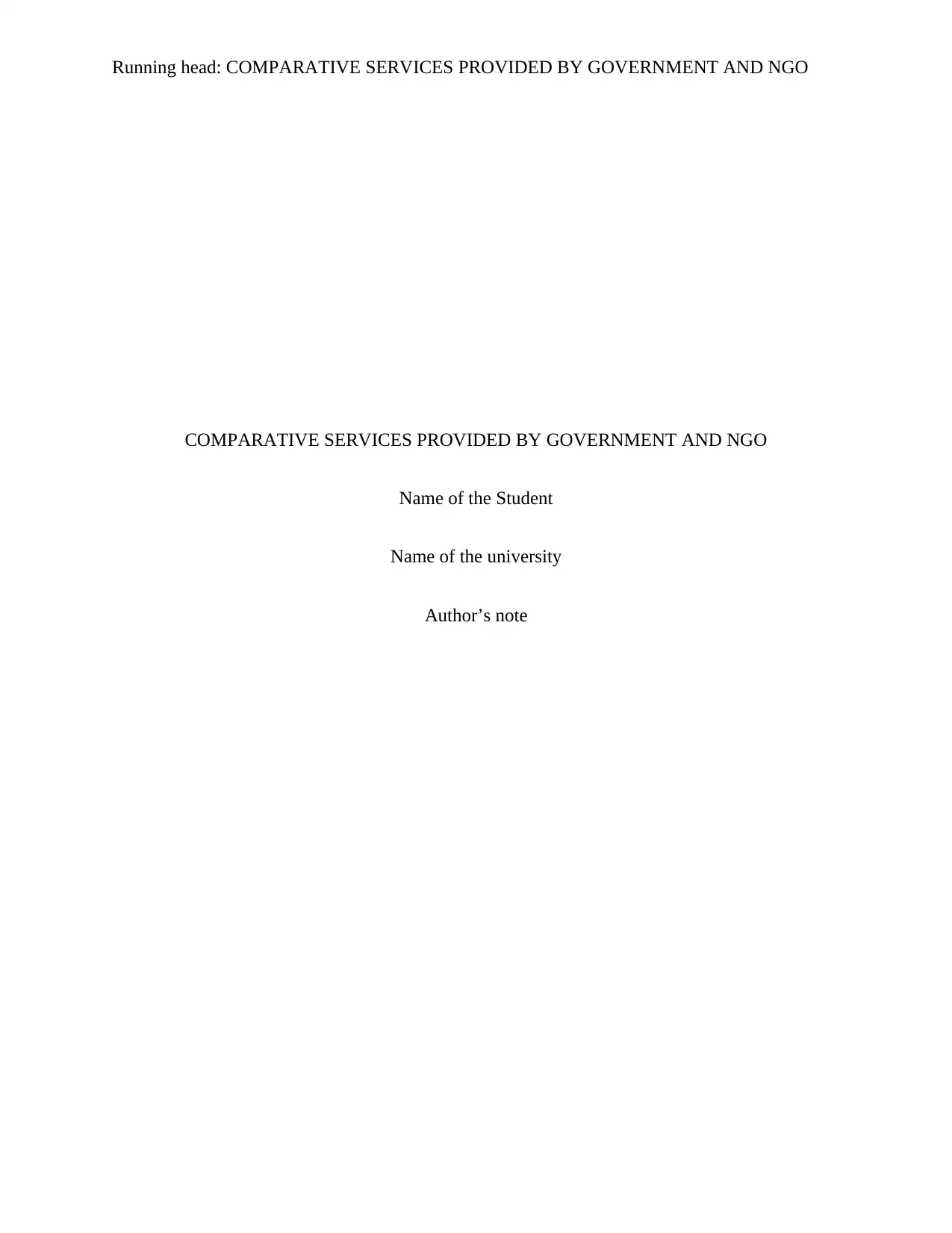
Running head: COMPARATIVE SERVICES PROVIDED BY GOVERNMENT AND NGO
COMPARATIVE SERVICES PROVIDED BY GOVERNMENT AND NGO
Name of the Student
Name of the university
Author’s note
COMPARATIVE SERVICES PROVIDED BY GOVERNMENT AND NGO
Name of the Student
Name of the university
Author’s note
Paraphrase This Document
Need a fresh take? Get an instant paraphrase of this document with our AI Paraphraser
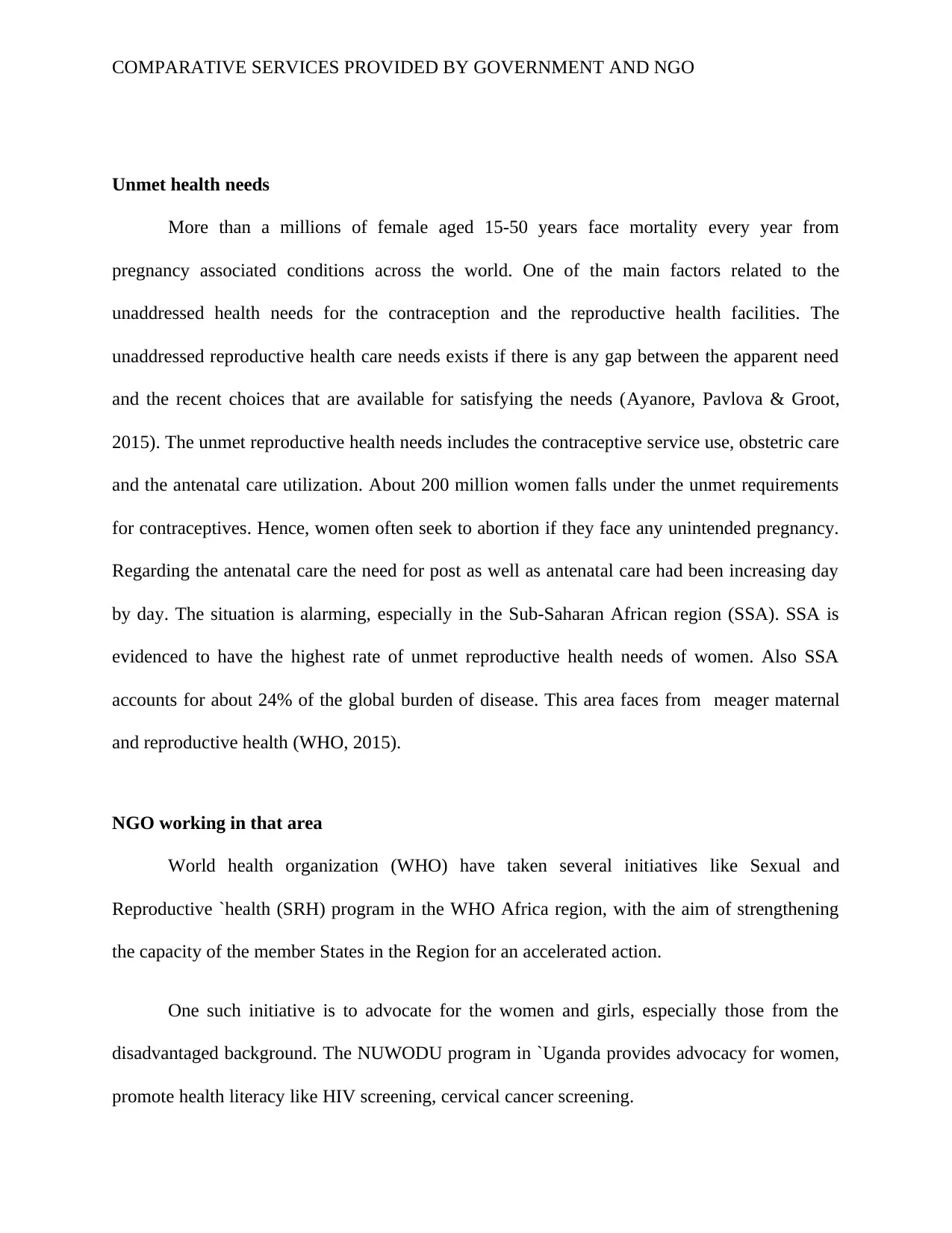
COMPARATIVE SERVICES PROVIDED BY GOVERNMENT AND NGO
Unmet health needs
More than a millions of female aged 15-50 years face mortality every year from
pregnancy associated conditions across the world. One of the main factors related to the
unaddressed health needs for the contraception and the reproductive health facilities. The
unaddressed reproductive health care needs exists if there is any gap between the apparent need
and the recent choices that are available for satisfying the needs (Ayanore, Pavlova & Groot,
2015). The unmet reproductive health needs includes the contraceptive service use, obstetric care
and the antenatal care utilization. About 200 million women falls under the unmet requirements
for contraceptives. Hence, women often seek to abortion if they face any unintended pregnancy.
Regarding the antenatal care the need for post as well as antenatal care had been increasing day
by day. The situation is alarming, especially in the Sub-Saharan African region (SSA). SSA is
evidenced to have the highest rate of unmet reproductive health needs of women. Also SSA
accounts for about 24% of the global burden of disease. This area faces from meager maternal
and reproductive health (WHO, 2015).
NGO working in that area
World health organization (WHO) have taken several initiatives like Sexual and
Reproductive `health (SRH) program in the WHO Africa region, with the aim of strengthening
the capacity of the member States in the Region for an accelerated action.
One such initiative is to advocate for the women and girls, especially those from the
disadvantaged background. The NUWODU program in `Uganda provides advocacy for women,
promote health literacy like HIV screening, cervical cancer screening.
Unmet health needs
More than a millions of female aged 15-50 years face mortality every year from
pregnancy associated conditions across the world. One of the main factors related to the
unaddressed health needs for the contraception and the reproductive health facilities. The
unaddressed reproductive health care needs exists if there is any gap between the apparent need
and the recent choices that are available for satisfying the needs (Ayanore, Pavlova & Groot,
2015). The unmet reproductive health needs includes the contraceptive service use, obstetric care
and the antenatal care utilization. About 200 million women falls under the unmet requirements
for contraceptives. Hence, women often seek to abortion if they face any unintended pregnancy.
Regarding the antenatal care the need for post as well as antenatal care had been increasing day
by day. The situation is alarming, especially in the Sub-Saharan African region (SSA). SSA is
evidenced to have the highest rate of unmet reproductive health needs of women. Also SSA
accounts for about 24% of the global burden of disease. This area faces from meager maternal
and reproductive health (WHO, 2015).
NGO working in that area
World health organization (WHO) have taken several initiatives like Sexual and
Reproductive `health (SRH) program in the WHO Africa region, with the aim of strengthening
the capacity of the member States in the Region for an accelerated action.
One such initiative is to advocate for the women and girls, especially those from the
disadvantaged background. The NUWODU program in `Uganda provides advocacy for women,
promote health literacy like HIV screening, cervical cancer screening.
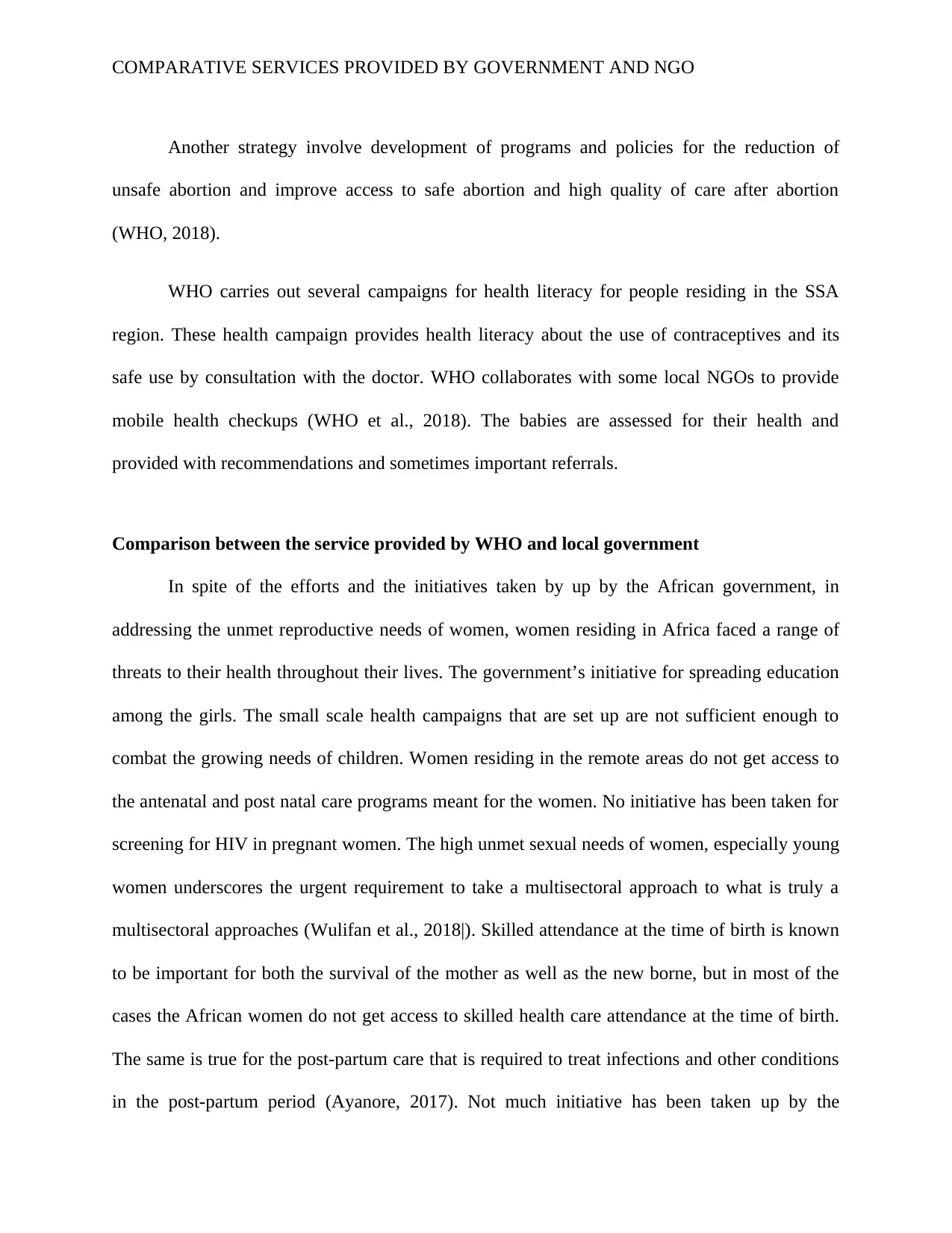
COMPARATIVE SERVICES PROVIDED BY GOVERNMENT AND NGO
Another strategy involve development of programs and policies for the reduction of
unsafe abortion and improve access to safe abortion and high quality of care after abortion
(WHO, 2018).
WHO carries out several campaigns for health literacy for people residing in the SSA
region. These health campaign provides health literacy about the use of contraceptives and its
safe use by consultation with the doctor. WHO collaborates with some local NGOs to provide
mobile health checkups (WHO et al., 2018). The babies are assessed for their health and
provided with recommendations and sometimes important referrals.
Comparison between the service provided by WHO and local government
In spite of the efforts and the initiatives taken by up by the African government, in
addressing the unmet reproductive needs of women, women residing in Africa faced a range of
threats to their health throughout their lives. The government’s initiative for spreading education
among the girls. The small scale health campaigns that are set up are not sufficient enough to
combat the growing needs of children. Women residing in the remote areas do not get access to
the antenatal and post natal care programs meant for the women. No initiative has been taken for
screening for HIV in pregnant women. The high unmet sexual needs of women, especially young
women underscores the urgent requirement to take a multisectoral approach to what is truly a
multisectoral approaches (Wulifan et al., 2018|). Skilled attendance at the time of birth is known
to be important for both the survival of the mother as well as the new borne, but in most of the
cases the African women do not get access to skilled health care attendance at the time of birth.
The same is true for the post-partum care that is required to treat infections and other conditions
in the post-partum period (Ayanore, 2017). Not much initiative has been taken up by the
Another strategy involve development of programs and policies for the reduction of
unsafe abortion and improve access to safe abortion and high quality of care after abortion
(WHO, 2018).
WHO carries out several campaigns for health literacy for people residing in the SSA
region. These health campaign provides health literacy about the use of contraceptives and its
safe use by consultation with the doctor. WHO collaborates with some local NGOs to provide
mobile health checkups (WHO et al., 2018). The babies are assessed for their health and
provided with recommendations and sometimes important referrals.
Comparison between the service provided by WHO and local government
In spite of the efforts and the initiatives taken by up by the African government, in
addressing the unmet reproductive needs of women, women residing in Africa faced a range of
threats to their health throughout their lives. The government’s initiative for spreading education
among the girls. The small scale health campaigns that are set up are not sufficient enough to
combat the growing needs of children. Women residing in the remote areas do not get access to
the antenatal and post natal care programs meant for the women. No initiative has been taken for
screening for HIV in pregnant women. The high unmet sexual needs of women, especially young
women underscores the urgent requirement to take a multisectoral approach to what is truly a
multisectoral approaches (Wulifan et al., 2018|). Skilled attendance at the time of birth is known
to be important for both the survival of the mother as well as the new borne, but in most of the
cases the African women do not get access to skilled health care attendance at the time of birth.
The same is true for the post-partum care that is required to treat infections and other conditions
in the post-partum period (Ayanore, 2017). Not much initiative has been taken up by the
⊘ This is a preview!⊘
Do you want full access?
Subscribe today to unlock all pages.

Trusted by 1+ million students worldwide
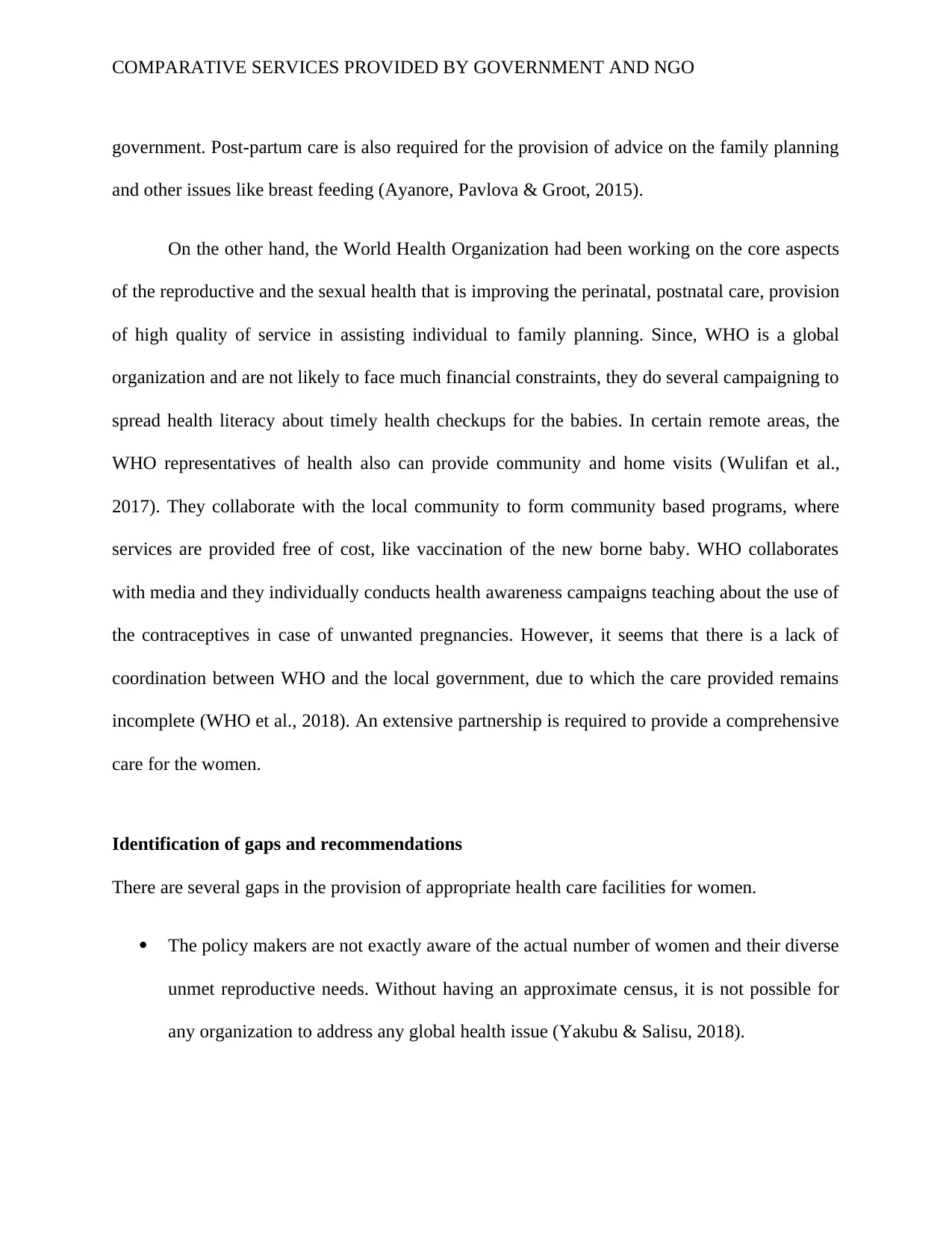
COMPARATIVE SERVICES PROVIDED BY GOVERNMENT AND NGO
government. Post-partum care is also required for the provision of advice on the family planning
and other issues like breast feeding (Ayanore, Pavlova & Groot, 2015).
On the other hand, the World Health Organization had been working on the core aspects
of the reproductive and the sexual health that is improving the perinatal, postnatal care, provision
of high quality of service in assisting individual to family planning. Since, WHO is a global
organization and are not likely to face much financial constraints, they do several campaigning to
spread health literacy about timely health checkups for the babies. In certain remote areas, the
WHO representatives of health also can provide community and home visits (Wulifan et al.,
2017). They collaborate with the local community to form community based programs, where
services are provided free of cost, like vaccination of the new borne baby. WHO collaborates
with media and they individually conducts health awareness campaigns teaching about the use of
the contraceptives in case of unwanted pregnancies. However, it seems that there is a lack of
coordination between WHO and the local government, due to which the care provided remains
incomplete (WHO et al., 2018). An extensive partnership is required to provide a comprehensive
care for the women.
Identification of gaps and recommendations
There are several gaps in the provision of appropriate health care facilities for women.
The policy makers are not exactly aware of the actual number of women and their diverse
unmet reproductive needs. Without having an approximate census, it is not possible for
any organization to address any global health issue (Yakubu & Salisu, 2018).
government. Post-partum care is also required for the provision of advice on the family planning
and other issues like breast feeding (Ayanore, Pavlova & Groot, 2015).
On the other hand, the World Health Organization had been working on the core aspects
of the reproductive and the sexual health that is improving the perinatal, postnatal care, provision
of high quality of service in assisting individual to family planning. Since, WHO is a global
organization and are not likely to face much financial constraints, they do several campaigning to
spread health literacy about timely health checkups for the babies. In certain remote areas, the
WHO representatives of health also can provide community and home visits (Wulifan et al.,
2017). They collaborate with the local community to form community based programs, where
services are provided free of cost, like vaccination of the new borne baby. WHO collaborates
with media and they individually conducts health awareness campaigns teaching about the use of
the contraceptives in case of unwanted pregnancies. However, it seems that there is a lack of
coordination between WHO and the local government, due to which the care provided remains
incomplete (WHO et al., 2018). An extensive partnership is required to provide a comprehensive
care for the women.
Identification of gaps and recommendations
There are several gaps in the provision of appropriate health care facilities for women.
The policy makers are not exactly aware of the actual number of women and their diverse
unmet reproductive needs. Without having an approximate census, it is not possible for
any organization to address any global health issue (Yakubu & Salisu, 2018).
Paraphrase This Document
Need a fresh take? Get an instant paraphrase of this document with our AI Paraphraser
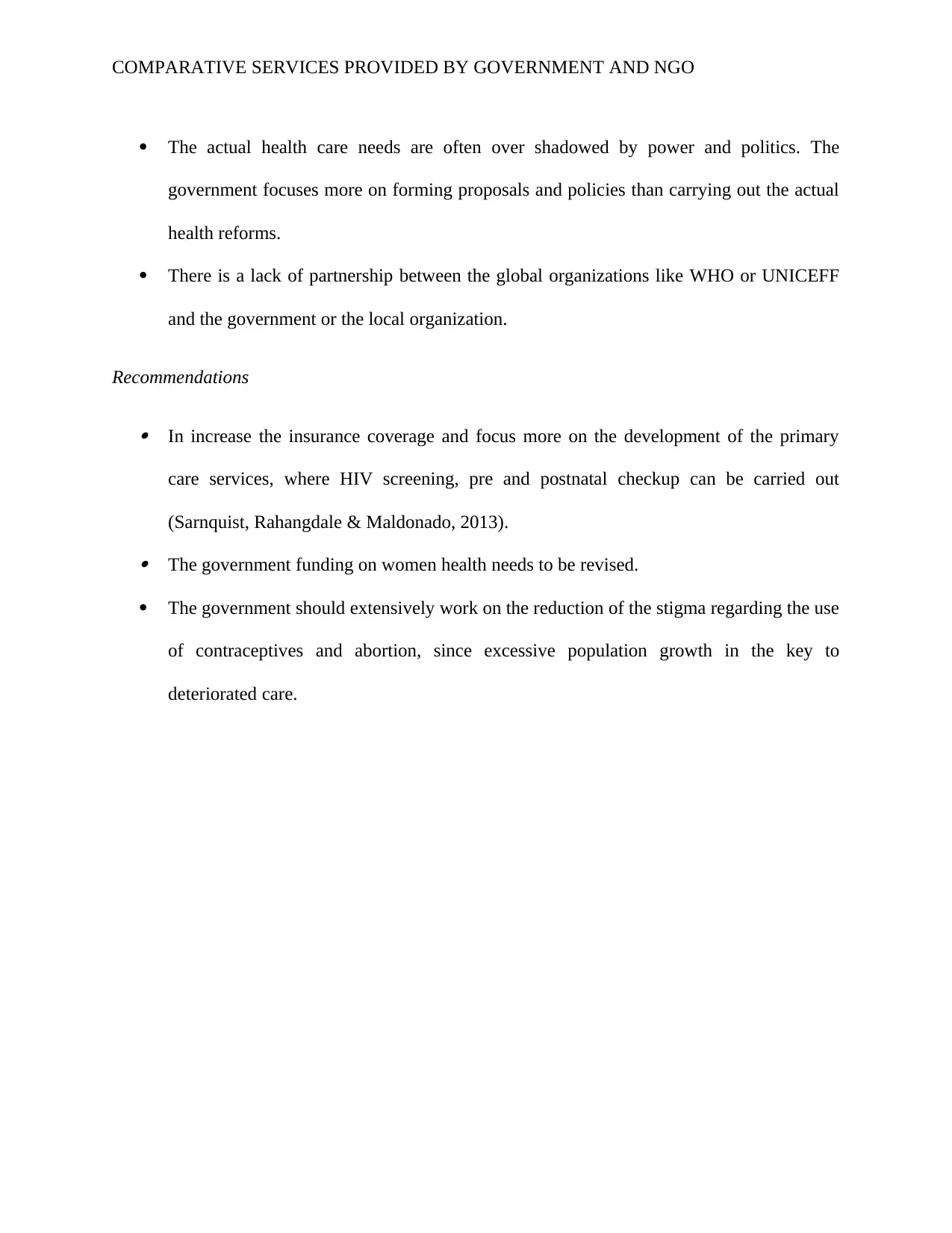
COMPARATIVE SERVICES PROVIDED BY GOVERNMENT AND NGO
The actual health care needs are often over shadowed by power and politics. The
government focuses more on forming proposals and policies than carrying out the actual
health reforms.
There is a lack of partnership between the global organizations like WHO or UNICEFF
and the government or the local organization.
Recommendations
In increase the insurance coverage and focus more on the development of the primary
care services, where HIV screening, pre and postnatal checkup can be carried out
(Sarnquist, Rahangdale & Maldonado, 2013). The government funding on women health needs to be revised.
The government should extensively work on the reduction of the stigma regarding the use
of contraceptives and abortion, since excessive population growth in the key to
deteriorated care.
The actual health care needs are often over shadowed by power and politics. The
government focuses more on forming proposals and policies than carrying out the actual
health reforms.
There is a lack of partnership between the global organizations like WHO or UNICEFF
and the government or the local organization.
Recommendations
In increase the insurance coverage and focus more on the development of the primary
care services, where HIV screening, pre and postnatal checkup can be carried out
(Sarnquist, Rahangdale & Maldonado, 2013). The government funding on women health needs to be revised.
The government should extensively work on the reduction of the stigma regarding the use
of contraceptives and abortion, since excessive population growth in the key to
deteriorated care.
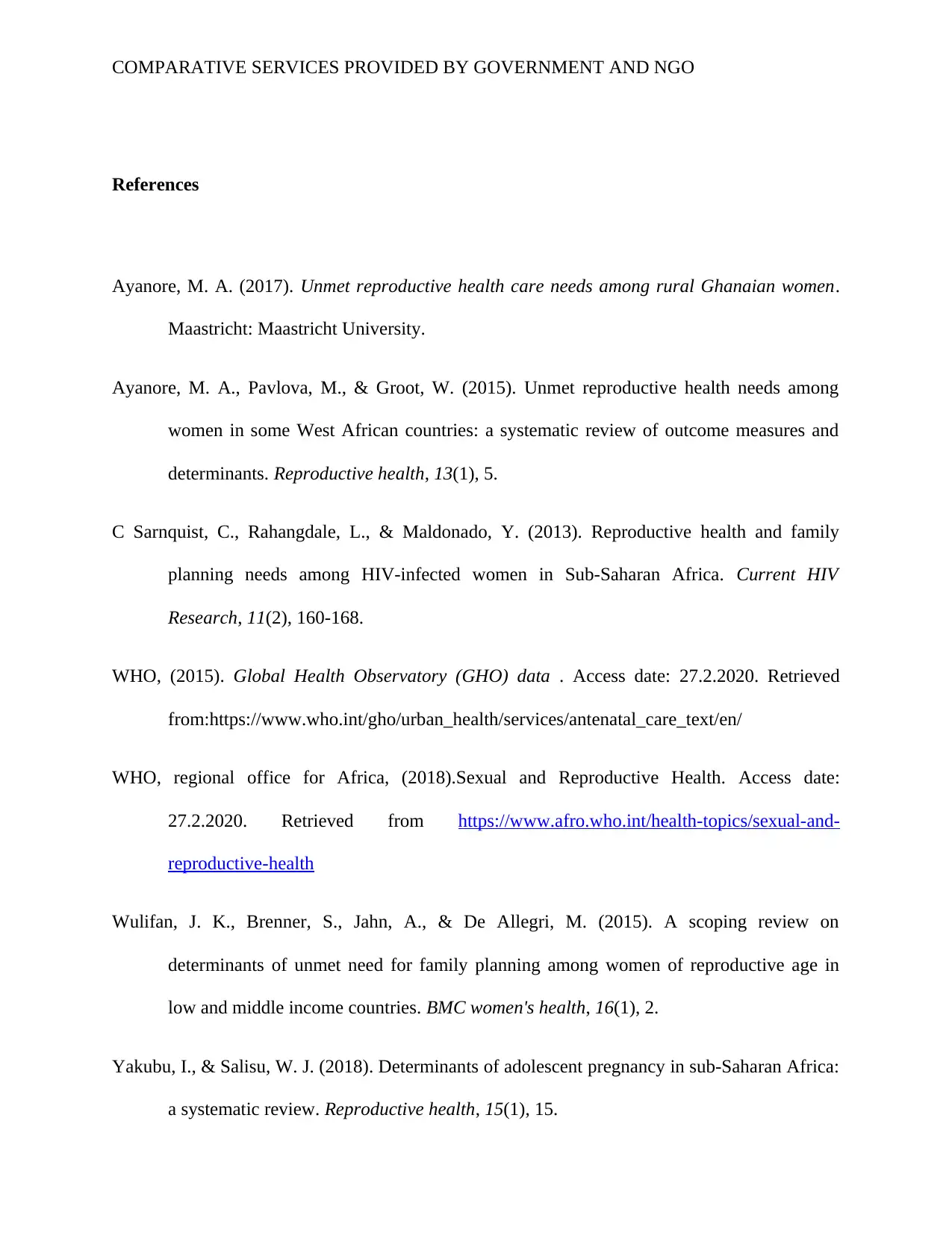
COMPARATIVE SERVICES PROVIDED BY GOVERNMENT AND NGO
References
Ayanore, M. A. (2017). Unmet reproductive health care needs among rural Ghanaian women.
Maastricht: Maastricht University.
Ayanore, M. A., Pavlova, M., & Groot, W. (2015). Unmet reproductive health needs among
women in some West African countries: a systematic review of outcome measures and
determinants. Reproductive health, 13(1), 5.
C Sarnquist, C., Rahangdale, L., & Maldonado, Y. (2013). Reproductive health and family
planning needs among HIV-infected women in Sub-Saharan Africa. Current HIV
Research, 11(2), 160-168.
WHO, (2015). Global Health Observatory (GHO) data . Access date: 27.2.2020. Retrieved
from:https://www.who.int/gho/urban_health/services/antenatal_care_text/en/
WHO, regional office for Africa, (2018).Sexual and Reproductive Health. Access date:
27.2.2020. Retrieved from https://www.afro.who.int/health-topics/sexual-and-
reproductive-health
Wulifan, J. K., Brenner, S., Jahn, A., & De Allegri, M. (2015). A scoping review on
determinants of unmet need for family planning among women of reproductive age in
low and middle income countries. BMC women's health, 16(1), 2.
Yakubu, I., & Salisu, W. J. (2018). Determinants of adolescent pregnancy in sub-Saharan Africa:
a systematic review. Reproductive health, 15(1), 15.
References
Ayanore, M. A. (2017). Unmet reproductive health care needs among rural Ghanaian women.
Maastricht: Maastricht University.
Ayanore, M. A., Pavlova, M., & Groot, W. (2015). Unmet reproductive health needs among
women in some West African countries: a systematic review of outcome measures and
determinants. Reproductive health, 13(1), 5.
C Sarnquist, C., Rahangdale, L., & Maldonado, Y. (2013). Reproductive health and family
planning needs among HIV-infected women in Sub-Saharan Africa. Current HIV
Research, 11(2), 160-168.
WHO, (2015). Global Health Observatory (GHO) data . Access date: 27.2.2020. Retrieved
from:https://www.who.int/gho/urban_health/services/antenatal_care_text/en/
WHO, regional office for Africa, (2018).Sexual and Reproductive Health. Access date:
27.2.2020. Retrieved from https://www.afro.who.int/health-topics/sexual-and-
reproductive-health
Wulifan, J. K., Brenner, S., Jahn, A., & De Allegri, M. (2015). A scoping review on
determinants of unmet need for family planning among women of reproductive age in
low and middle income countries. BMC women's health, 16(1), 2.
Yakubu, I., & Salisu, W. J. (2018). Determinants of adolescent pregnancy in sub-Saharan Africa:
a systematic review. Reproductive health, 15(1), 15.
⊘ This is a preview!⊘
Do you want full access?
Subscribe today to unlock all pages.

Trusted by 1+ million students worldwide
1 out of 6
Related Documents
Your All-in-One AI-Powered Toolkit for Academic Success.
+13062052269
info@desklib.com
Available 24*7 on WhatsApp / Email
![[object Object]](/_next/static/media/star-bottom.7253800d.svg)
Unlock your academic potential
Copyright © 2020–2025 A2Z Services. All Rights Reserved. Developed and managed by ZUCOL.



